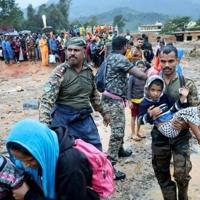Rescue operations were hindered on Wednesday by relentless downpours and strong winds in the aftermath of landslides in Indian tea plantations that claimed the lives of at least 150 people, most of whom were believed to be laborers and their families.
The state of Kerala in southern India has been severely impacted by days of heavy monsoon rains, making it challenging for relief efforts to reach the disaster area in the Wayanad district due to blocked roads.
One of the bridges connecting the worst-hit villages, Chooralmala and Mundakkai, was washed away, forcing rescue teams to transport bodies on stretchers out of the disaster zone using a temporary zipline over flooded waters.
Some survivors who escaped the initial landslides found themselves trapped in a nearby river that overflowed its banks, according to Arun Dev, a volunteer rescuer assisting at a hospital where survivors were being treated.
Around 500 people have been rescued since multiple landslides occurred before dawn on Tuesday, with over 150 bodies recovered, according to Senior Police Officer M.R. Ajith Kumar.
Wayanad is known for its tea estates, which employ a large number of laborers for plantation and harvesting activities.
The devastating landslides submerged several brick-walled row homes where seasonal workers resided, along with their families, as they slept indoors.
The catastrophic debris flows caused by the landslides made survival extremely difficult, exacerbated by the timing of the incident and the inadequate protection offered by flimsy structures, explained Hull University earth scientist Dave Petley.
More than 3,000 individuals were seeking shelter in emergency relief camps across Wayanad district, as heavy rainfall continued to pose a threat, with additional rain and strong winds forecasted for the following day.
– ‘Adverse weather conditions’ –
Rahul Gandhi, an Indian opposition leader representing Wayanad, had to cancel a planned visit to the disaster area due to incessant rains and adverse weather conditions.
Monsoon rains during the June to September period are essential for agriculture and water supply replenishment, but they also bring destruction, with an increase in fatal floods and landslides in recent years, possibly exacerbated by climate change.
India’s history of devastating landslides includes a tragic incident in 1998 when heavy monsoon rains triggered rockfalls that killed over 220 people in the Himalayan village of Malpa.
The impact of climate change on such natural disasters is a growing concern, and experts warn that India may face more severe impacts in the future due to damming, deforestation, and development projects.
ash/gle/smw





